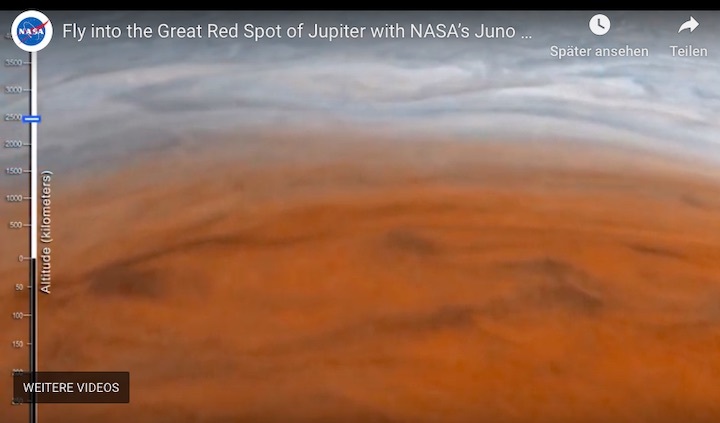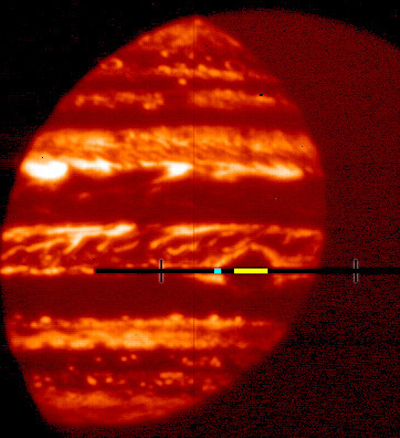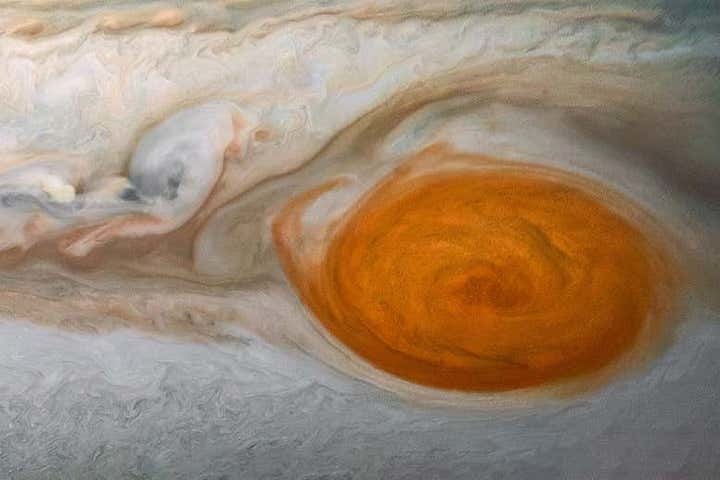22.01.2019
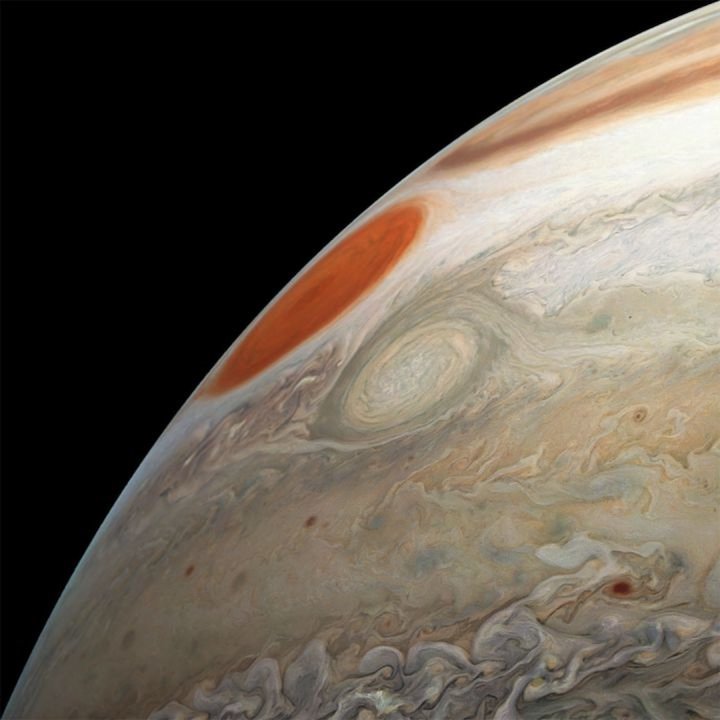
Credit: NASA/JPL-Caltech/SwRI/MSSS/Gerald Eichstädt/Seán Doran
NASA's Juno spacecraft made another pass over Jupiter's surface late last month, and the data is back — including this stunning view of two enormous storms swirling across the gas giant.
Accompanying the famous Great Red Spot storm in this image is a second storm nicknamed Oval BA. Unlike its larger russet companion, Oval BAformed under scientists' eyes, when three smaller storms collided in 2000.
The visible-light camera on board Juno, called JunoCam, has been able to watch Oval BA change over the course of the mission, with the storm becoming paler since a previous visit nearly a year ago, according to a statement from the Southwest Research Institute, which manages the mission.
The image consists of three separate photographs combined and digitally enhanced by volunteer imaging experts here on Earth. JunoCam captured the images when it was between 23,800 miles and 34,500 miles (38,300 and 55,500 kilometers) above Jupiter's clouds. The three photographs were taken during a 10-minute period on Dec. 21, during the spacecraft's 16th close science flyby of Jupiter.
Last month's flyby marks the halfway point of Juno's mission, which was carefully designed to cover the entire surface of the gas giant in 32 flybys. The spacecraft will remain at work until July 2021 to complete those orbits. Its next close approach will come on Feb. 12.
Quelle: SC
----
Update: 24.02.2019
.
NASA's Juno Spacecraft Just Sent Back A Stunning Photo Of Jupiter's Mysterious Giant Jet-Stream
NASA's Juno spacecraft, which has been orbiting the giant planet Jupiter since summer 2016, is getting dangerously close to challenging other NASA's planetary spacecraft Cassini and Voyager for true iconic status.
Its little solar-powered probe has just sent back a trove of incredible images from its latest 'dip' towards Jupiter, including this incredible image (below) of swirling clouds that surround a circular feature within a jet stream region called 'Jet N6.'
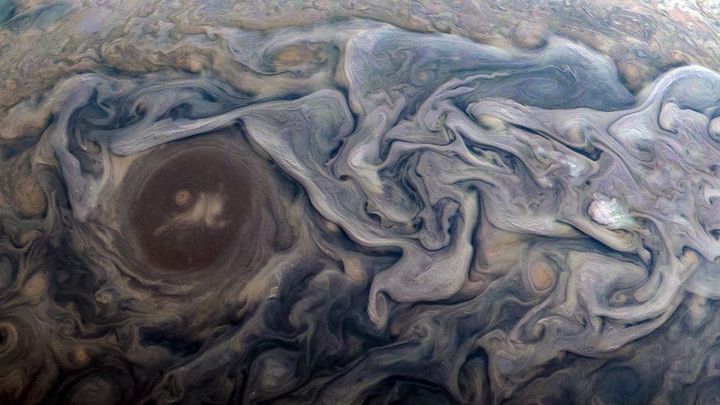
Swirling clouds within Jupiter's Jet N6 jet-stream, taken at 9:20 a.m. PST (12:20 p.m. EST) on Feb. 12, 2019, as the spacecraft performed its 18th close flyby of the gas giant planet.NASA/JPL-CALTECH/SWRI/MSSS/KEVIN M. GILL
This color-enhanced image was created by 'citizen scientist' Kevin M. Gill image using data from the spacecraft's JunoCam imager. It was taken on Feb. 12, 2019, as the spacecraft performed its 18th close flyby of the gas giant planet. NASA says that Juno was about 8,000 miles (13,000 kilometers) from the planet's cloud tops when it snapped the photo.
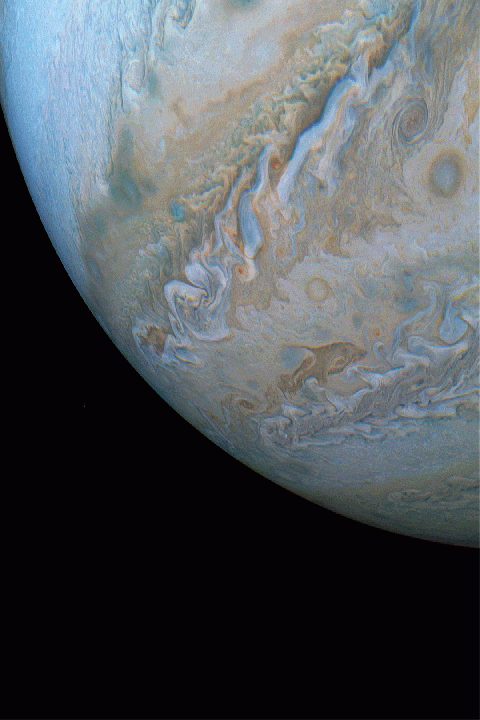
In November 2018, Juno tool these images of a cloud in the shape of a dolphin appearing to swim through the cloud bands along Jupiter's South South Temperate Belt.NASA/JPL-CALTECH/SWRI/MSSS/BRIAN SWIFT/SEÁN DORAN
NASA is making the raw images from JunoCam available online to anyone who wants to look at them, or like Gill, process them.
The latest collection of raw images is from what NASA calls Juno's 'Perijove 18'. A perijove is essentially a close flyby of Jupiter. Juno is in a big polar orbit of the giant planet, and every 53 days it passes just 3,000 miles shy of Jupiter’s cloud tops. That's when it's taking all of its photos, so expect a 'data dump' every couple of months.
Juno's mission was replanned last June after concerns over valves on its fule system. Either way, Juno will crash into Jupiter in July 2021.
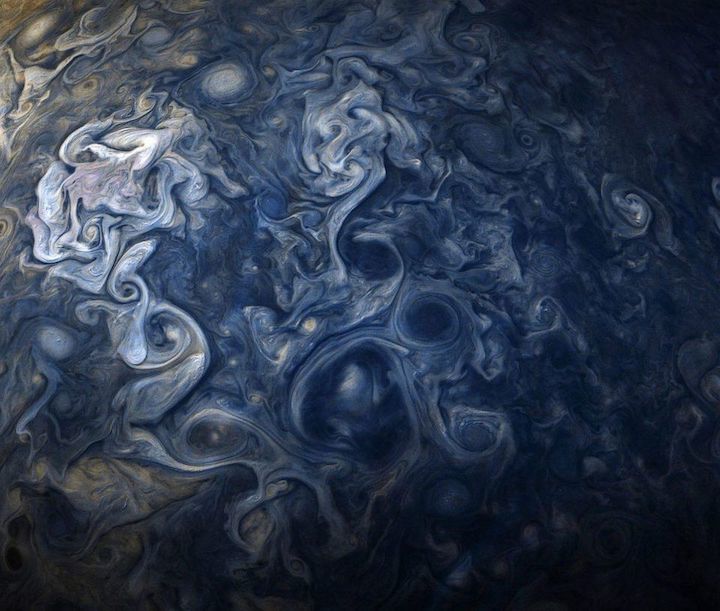
'Jupiter Blues' was taken in November 2017 and processed by citizen scientists Gerald Eichstädt and Seán Doran.NASA/JPL-CALTECH/SWRI/MSSS/GERALD EICHSTADT/SEAN DORAN
Quelle: Forbes
----
Update: 3.03.2019
.
Breathtaking photo of Jupiter clouds looks like a work of art: 'Van Gogh is that you?'
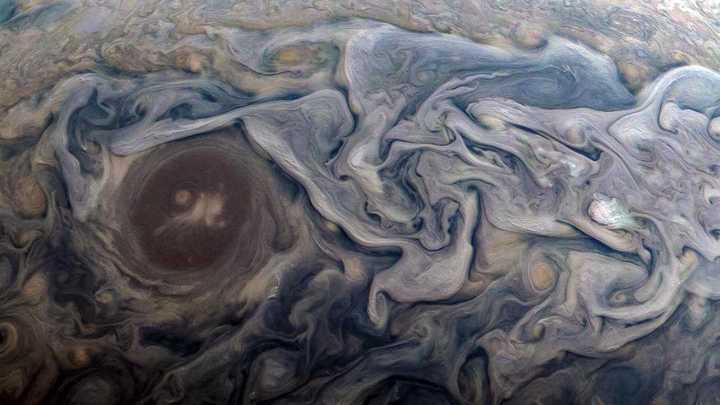
An image captured by NASA's Jupiter spacecraft paints a stunning picture of the planet's swirling clouds.
The image, color-enhanced by software engineer Kevin M. Gill, was created using data from the spacecraft's JunoCam imager.
The view is of a jet stream region named "Jet N6" at 12:20 p.m. EST on Feb. 12. At the time, NASA reports Juno was about 8,000 miles from the planet's cloud tops.
On Twitter, people compared the image to famous artists including Claude Monet and Jack Pollock paintings. Several users asked, "Van Gogh is that you?"
This isn't the first time we've seen an artful photo of the planet. In June, NASA released an image of the Jupiter's "chaotic and turbulent" clouds, with swirling formations and several vortices in the giant planet's northern hemisphere.
More: NASA releases 'turbulent' photo of Jupiter's clouds
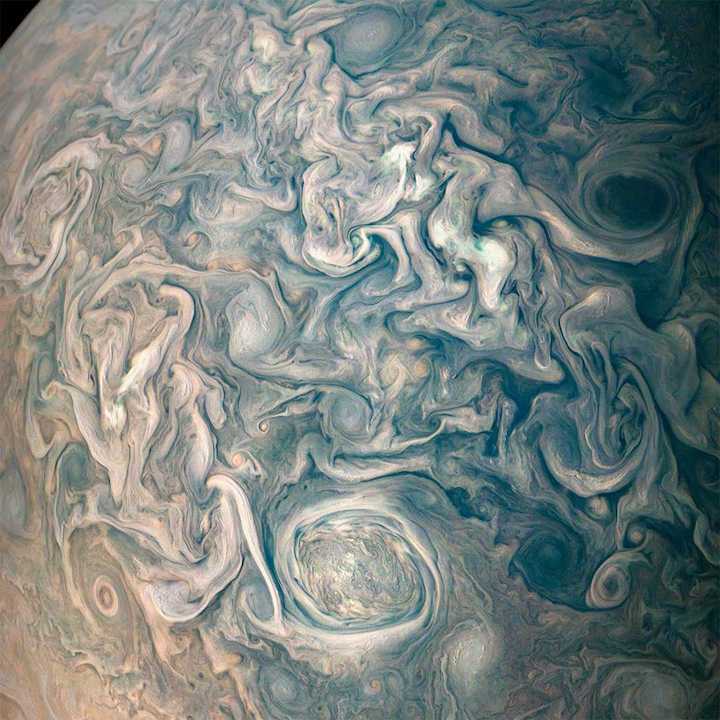
NASA's Juno Finds Changes in Jupiter's Magnetic Field
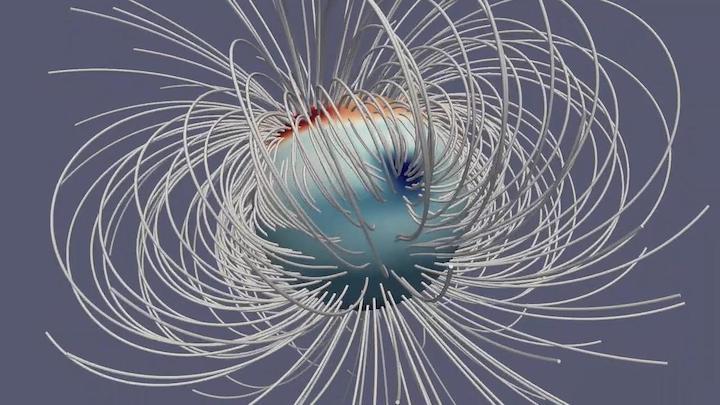
This still from an animation illustrates Jupiter's magnetic field at a single moment in time. The Great Blue Spot, an-invisible-to-the-eye concentration of magnetic field near the equator, stands out as a particularly strong feature. Image credit: NASA/JPL-Caltech/Harvard/Moore et al.
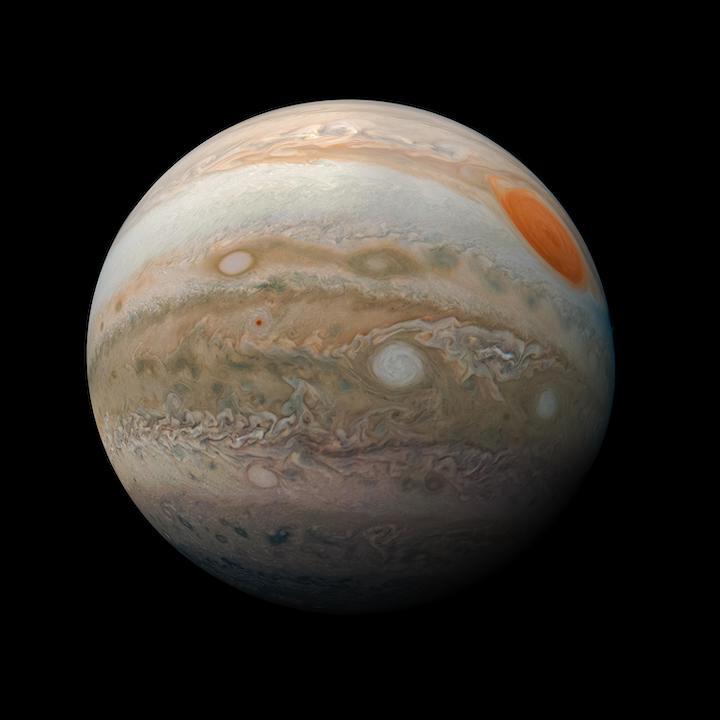
This striking view of Jupiter's Great Red Spot and turbulent southern hemisphere was captured by NASA's Juno spacecraft as it performed a close pass of the gas giant planet.
Juno took the three images used to produce this color-enhanced view on Feb. 12, 2019, between 9:59 a.m. PST (12:59 p.m. EST) and 10:39 a.m. PST (1:39 p.m. EST), as the spacecraft performed its 17th science pass of Jupiter. At the time the images were taken, the spacecraft was between 16,700 miles (26,900 kilometers) and 59,300 miles (95,400 kilometers) above Jupiter's cloud tops, above a southern latitude spanning from about 40 to 74 degrees.
Citizen scientist Kevin M. Gill created this image using data from the spacecraft's JunoCam imager.
-
NASA's Juno mission to Jupiter made the first definitive detection beyond our world of an internal magnetic field that changes over time, a phenomenon called secular variation. Juno determined the gas giant's secular variation is most likely driven by the planet's deep atmospheric winds.
The discovery will help scientists further understand Jupiter's interior structure - including atmospheric dynamics - as well as changes in Earth's magnetic field. A paper on the discovery was published today in the journal Nature Astronomy.
"Secular variation has been on the wish list of planetary scientists for decades," said Scott Bolton, Juno principal investigator from the Southwest Research Institute in San Antonio. "This discovery could only take place due to Juno's extremely accurate science instruments and the unique nature of Juno's orbit, which carries it low over the planet as it travels from pole to pole."
Characterizing the magnetic field of a planet requires close-up measurements. Juno scientists compared data from NASA's past missions to Jupiter (Pioneer 10 and 11, Voyager 1 and Ulysses) to a new model of Jupiter's magnetic field (called JRM09). The new model was based on data collected during Juno's first eight science passes of Jupiter using its magnetometer, an instrument capable of generating a detailed three-dimensional map of the magnetic field.
What scientists found is that from the first Jupiter magnetic field data provided by the Pioneer spacecraft through to the latest data provided by Juno, there were small but distinct changes to the field.
"Finding something as minute as these changes in something so immense as Jupiter's magnetic field was a challenge," said Kimee Moore, a Juno scientist from Harvard University in Cambridge, Massachusetts. "Having a baseline of close-up observations over four decades long provided us with just enough data to confirm that Jupiter's magnetic field does indeed change over time."
Once the Juno team proved secular variation did occur, they sought to explain how such a change might come about. The operation of Jupiter's atmospheric (or zonal) winds best explained the changes in its magnetic field. These winds extend from the planet's surface to over 1,860 miles (3,000 kilometers) deep, where the planet's interior begins changing from gas to highly conductive liquid metal. They are believed to shear the magnetic fields, stretching them and carrying them around the planet.
Nowhere was Jupiter's secular variation as large as at the planet's Great Blue Spot, an intense patch of magnetic field near Jupiter's equator. The combination of the Great Blue Spot, with its strong localized magnetic fields, and strong zonal winds at this latitude result in the largest secular variations in the field on the Jovian world.
"It is incredible that one narrow magnetic hot spot, the Great Blue Spot, could be responsible for almost all of Jupiter's secular variation, but the numbers bear it out," said Moore. "With this new understanding of magnetic fields, during future science passes we will begin to create a planetwide map of Jupiter's secular variation. It may also have applications for scientists studying Earth's magnetic field, which still contains many mysteries to be solved."
NASA's JPL manages and operates the Juno mission for the principal investigator, Scott Bolton, of the Southwest Research Institute in San Antonio. Juno is part of NASA's New Frontiers Program, which is managed by NASA's Marshall Space Flight Center in Huntsville, Alabama, for the agency's Science Mission Directorate. The Italian Space Agency (ASI) contributed two instruments, a Ka-band frequency translator (KaT) and the Jovian Infrared Auroral Mapper (JIRAM). Lockheed Martin Space in Denver built and operates the spacecraft.
Quelle: NASA
----
Update: 16.07.2019
.


